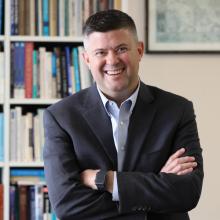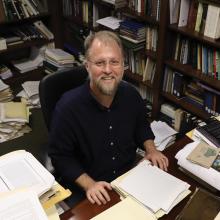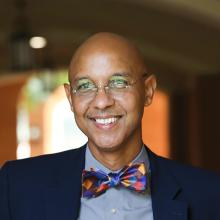Expanded Perspectives
It’s common to hear about large national foundations, corporations and government agencies providing generous grants to fund scientific research. But recently, Baylor Arts & Sciences faculty members in the humanities have received prestigious national grants to fund projects that will introduce high school educators to new approaches to teaching.
Asking the Big Questions
As part of their education, high school students today are taught how to solve very specific problems such as how to establish the area of a plot of land, how to construct a proper sentence, and how to place World War II in the timeline of history. But as part of their curriculum, these students are rarely asked to grapple with the “big questions” of human existence — Who are we? Why are we here? What do we owe each other as fellow human beings? What does it mean to succeed in life?
Developing a means to help high school teachers successfully introduce their students to an age-old method of discussing such “wisdom questions” is the purpose of a $100,000 grant received by Baylor’s Dr. Todd Buras from the National Endowment for the Humanities (NEH). Buras, chair and associate professor of philosophy in the College of Arts & Sciences, shares the grant with co-director Dr. Phillip Donnelly, associate professor and director of the Great Texts Program in Baylor’s Honors College.
The NEH grant provides the means for Buras and Donnelly to research, create and then put on a summer seminar for high school teachers called “Disputatio and the Pursuit of Wisdom in the Humanities.” Buras said the disputatio is a format of thinking through wisdom questions that can be traced all the way back to medieval times when they were adapted from the philosophers Socrates and Aristotle. In later years it was used just as masterfully by philosophers and commentators such as Saint Thomas Aquinas.
“The disputatio is to wisdom questions what the scientific method is to knowledge questions,” Buras said. “It’s a step-by-step process for producing a stable and communicable result, but it’s not the final word by any means on questions in the humanities. It’s just a way of posing questions and developing answers, then building on those answers.”
Buras said that the disputatio is not a means of telling students what to think about the bigger questions in life, but it simply provides them with a framework to use in thinking about those questions themselves, then coming to their own conclusions. He said such discussions used to be a part of public education in America, but the rise of the scientific method has eclipsed the discussion of questions without verifiable answers.
“In public discourse, we have questions that can be answered by science, and we consider those facts,” Buras said. “Everything else we consider mere opinion, to which nobody owes anybody an explanation. You can just assert your preferences and expect them to be respected. But there is a third category in between those — questions that can’t be settled by science, but are not mere opinions. For these questions, we should be able to give a reasoned defense of the answers we come to. The field of ethics is the best example of this.”
By using the disputatio, Buras said students can take part with confidence in discussions about the major concerns of modern society.
“The goal is to equip students to take a well-reasoned stand in humanity’s conversations about some great question,” Buras said. “The goal is not to produce a final result. With the disputatio, you’re out to teach students to pull up a seat and be able to say something about, say, what our moral obligations are, or why it should be our duty not to cheat.”
Buras and Donnelly are using the grant funds to create the materials and obtain the services of fellow instructors that will allow them to offer a two-week, online seminar for 16 high school teachers from around the country in the summer of 2021. These participants will be teachers of such subjects as history, government and English in public schools, as well as additional subjects such as philosophy and religion sometimes offered in private schools.
“The NEH grant will also allow us to build a website that publishes what we’ve taught and disseminates the products we create, so that we can reach more than the 16 people who attend the first seminar,” Buras said, adding that he hopes to obtain additional funding in the future to expand the program.
Expanding the Narrative
Another Baylor recipient of a significant grant from the National Endowment for the Humanities is Dr. Ronald Angelo Johnson, The Ralph and Bessie Mae Lynn Chair of History, who joined the faculty in the fall of 2020. The $146,000 grant will fund the establishment and presentation of a three-week institute for K-12 teachers on “Teaching the History and Culture of Vast Early America.” Johnson co-directs the grant project with Dr. Karin Wulf, the executive director of the Omohundro Institute of Early American History and Culture and a professor of history at the College of William & Mary.
The teacher institute that Johnson and Wulf are working to create will introduce educators to the concept of “Vast Early America,” a term coined by Wulf that involves enlarging the story of America’s history and development.
“The way in which traditional early American history has been taught, and in many cases continues to be taught, tells the story of an westward progression across the United States. It tells about Europeans coming on the eastern shores and making their way toward the Pacific Ocean,” Johnson said. “A Vast Early America empowers instructors and students to … bring in other groups along with Europeans who were living together in what we now call the United States, some before the arrival of the Europeans.”
As an example, Johnson said that in the conventional narrative, Texas sometimes isn’t introduced in history classes until the early 1800s with the Texas Revolution.
“Vast Early America offers a way for Texas historians and teachers to begin the narrative of the United States more than a century before the European arrivals in Virginia and Massachusetts,” Johnson said. “In this part of the country, not all of us came here from the East. Many more Texans came across the Rio Grande than through Ellis Island.”
The idea of Vast Early America also provides for a more comprehensive history for groups such as Native Americans and African Americans.
“When educators do not introduce Native Americans into the U.S. story until Jamestown and Plymouth Rock in the 1600s, or until the Trail of Tears in the 1830s, our students are left to conceive and view members of native groups through the prism of being an oppressed people,” Johnson said. “It’s a similar dynamic with the history of African Americans. People of African descent are generally introduced into American history in 1619, when enslaved Africans first arrived in Virginia. Although that’s a very important date, if that’s when we begin to teach about the history of people of color, we sow the seeds in the minds of young students that African Americans were inferior people. And that’s not a very effective way of teaching about the peoples of the United States.”
Johnson said Vast Early America also incorporates the history and movements of people groups in the Caribbean, including persons who emigrated to the United States. The first U.S. Secretary of the Treasury, Alexander Hamilton, was born on the Caribbean island of Nevis and arrived in the United States as a student from St. Croix.
“I can imagine that across the Caribbean, particularly in the U.S. territories, it is very important for teachers to empower students to see themselves as part of the American story before the 20th century,” Johnson said.
By expanding the timeline and geographic scope of American history and sharing the stories of more groups and peoples, Johnson said the Vast Early America approach should get more students excited about learning history.
“Many students don’t like history because they don’t see themselves in it. They don’t see any relevancy of early Americans for themselves. And that’s not just students of color — that’s white American students as well,” he said. “What Vast Early America allows us to do is make history much more expansive, and also more relevant to the students learning it. And when history is more relevant, students are more engaged by it.”
On a larger note, Johnson believes that expanding the American story also has the possibility of affecting the nation’s future as a whole.
“I think it will help us as a nation deal with many of the problems we’re facing today because we continue to deal with problems in today’s world that are rooted in our beginnings as a nation,” he said.
The first Vast Early America teachers institute will debut in summer 2022 and will be held at the Omohundro Institute of Early American History and Culture at the College of William & Mary. It will feature presentations by multiple historical scholars, centering on different aspects of American history.
“I’ve already begun to approach colleagues in the Baylor faculty to gauge their interest in sharing their scholarship at the institute,” Johnson said.


